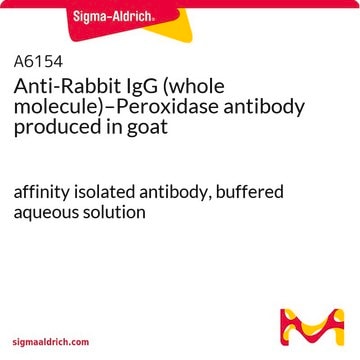推荐产品
生物源
mouse
共軛
unconjugated
抗體表格
ascites fluid
抗體產品種類
secondary antibodies
無性繁殖
RG-96, monoclonal
包含
15 mM sodium azide
物種活性
rabbit
應無反應活性
goat, feline, pig, guinea pig, rat, bovine, canine, human, horse, sheep, chicken
技術
dot blot: suitable
immunohistochemistry (formalin-fixed, paraffin-embedded sections): suitable
immunohistochemistry (frozen sections): suitable
indirect ELISA: 1:2,000
western blot: suitable
同型
IgG1
運輸包裝
dry ice
儲存溫度
−20°C
目標翻譯後修改
unmodified
正在寻找类似产品? 访问 产品对比指南
一般說明
Monoclonal Anti-Rabbit IgG (mouse IgG1 isotype) is derived from the hybridoma produced by the fusion of mouse myeloma cells and splenocytes from an immunized mouse. Immunoglobulins (Igs) belongs immunoglobulin super-family. There are five different types of immunoglobulins. Each immunoglobulin has two heavy (H) and two light (L), held together by disulphide linkages. Each light comprises one variable N-terminal region and a constant C-terminal region. Heavy chain has one variable N-terminal region and three or four constant (CH1-CH4) C-terminal region.
The product recognizes an epitope located on the γ (heavy)-chain of rabbit IgG. In immunoblotting, the antibody recognizes both native and denatured forms of rabbit IgG. In ELISA, the antibody is specific for rabbit IgG, and shows no cross-reactivity with rabbit IgA and IgM or human IgG, IgA, and IgM. No cross reaction is observed with IgG from the following species: bovine, cat, chicken, dog, goat, guinea pig, horse, pig, rat, or sheep.
特異性
Monoclonal Anti-Rabbit IgG is specific for an epitope located on the heavy (γ) chain of rabbit IgG, in an immunoblot of denatured, reduced rabbit IgG. The antibody does not react with rabbit IgA, IgM or light chains. No cross reactivity is observed with IgG from bovine, cat, chicken, dog, goat, guinea pig, horse, human, pig, rat or sheep.
應用
Monoclonal Anti-Rabbit IgG (γ-chain specific) antibody produced in mouse has been used in
- enzyme linked immunosorbent assay (ELISA)
- dot blots
- immunohistology
- western blotting
- peptide mass fingerprinting (PMF)
生化/生理作用
Digestion of IgG by papain generates fragment antigen binding (Fab). Pepsin digestion of IgG results in fragment crystallisable (fc). IgG antibody has enormous therapeutic potential and the Fc region is involved in the development of therapeutic antibody.
外觀
The product is provided as ascites fluid with 15 mM sodium azide (see MSDS) as a preservative.
儲存和穩定性
For continuous use, store at 2-8 °C for up to one month. For extended storage, the solution may be frozen in working aliquots. Repeated freezing and thawing is not recommended. Storage in "frost-free" freezers not recommended. If slight turbidity occurs upon prolonged storage, clarify the solution by centrifugation before use.
免責聲明
Unless otherwise stated in our catalog or other company documentation accompanying the product(s), our products are intended for research use only and are not to be used for any other purpose, which includes but is not limited to, unauthorized commercial uses, in vitro diagnostic uses, ex vivo or in vivo therapeutic uses or any type of consumption or application to humans or animals.
未找到合适的产品?
试试我们的产品选型工具.
儲存類別代碼
10 - Combustible liquids
水污染物質分類(WGK)
nwg
閃點(°F)
Not applicable
閃點(°C)
Not applicable
Jeremy K Brown et al.
The American journal of pathology, 165(1), 95-106 (2004-06-25)
Peak intestinal mucosal mast cell (MMC) recruitment coincides with expulsion of Trichinella spiralis, at a time when the majority of the MMCs are located within the epithelium in BALB/c mice. Although expression of integrin-alpha(E)beta(7) by MMCs has not been formally
Specificity in killing pathogens is mediated by distinct repertoires of human neutrophil peptides
Cederlund A, et al.
Journal of Innate Immunity, 2(6), 508-521 (2010)
Andreas Cederlund et al.
Journal of innate immunity, 2(6), 508-521 (2010-09-08)
Neutrophil-derived antimicrobial peptides and proteins (AMPs) play an important role in the defense against microbes. Absence of defense is illustrated by neutropenic patients with frequent bacterial and fungal infections. However, the specificity of the antimicrobial effects has not been adequately
Rossalyn M Day et al.
Cell stress & chaperones, 8(2), 183-193 (2003-11-25)
Small heat shock/alpha-crystallin proteins function as molecular chaperones, protecting other proteins from irreversible denaturation by an energy-independent process. The brine shrimp, Artemia franciscana, produces a small heat shock/alpha-crystallin protein termed p26, found in embryos undergoing encystment, diapause, and metabolic arrest.
Presenilins are enriched in endoplasmic reticulum membranes associated with mitochondria
Area-Gomez E, et al.
The American Journal of Pathology, 175(5), 1810-1816 (2009)
我们的科学家团队拥有各种研究领域经验,包括生命科学、材料科学、化学合成、色谱、分析及许多其他领域.
联系技术服务部门







